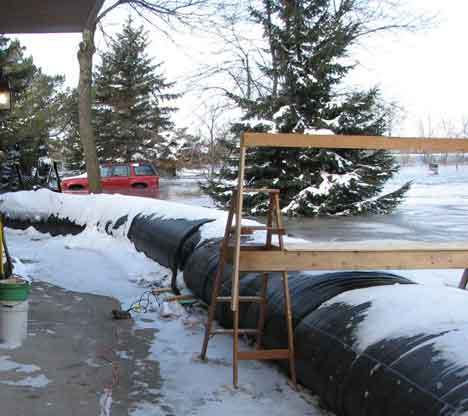Kent city officials plan to use large, water-filled tubes placed atop levees to help reduce the risk of flooding this winter along the Green River because of the expected lower storage capacity at Howard Hanson Dam.
The City Council unanimously approved a motion July 7 authorizing the public works department to purchase the aqua tubes at a cost of up to $1.5 million.
“It’s one proven method of flood control,” said Larry Blanchard, city public works director, at the Council meeting. “With an aqua dam, we can place it from one end of Kent to the other or at strategic locations.”
Blanchard said the city needs an emergency-response plan because of the potential flooding if the Howard Hanson Dam can’t operate at full capacity to hold back floodwaters.
Water leaking through a damaged abutment at the dam has yet to be resolved by the U.S. Army Corps of Engineers, the federal agency in charge of the flood-control dam. The leak increases the risk of flooding this winter in the Green River Valley and the cities of Kent, Auburn, Renton and Tukwila.
“This is totally proactive to minimize the flooding that could potentially occur,” Blanchard said.
The portable tubes, typically made with polyethylene, come on spools and can be rolled out, similar to a wire cable, along river levees. Pumps are then used to fill the tubes with water from the river, to form an additional barricade on the tops of levees. The tubes can be emptied, stored and used again.
The tubes are about 3 feet high and can add an additional 3,000 cubic feet per second of river flow to levee flood-retention, wherever the tubes are placed. The tubes are connected and can be stretched for long distances.
Steve Bleifuhs is the section manager for King County River and Floodplain Management, an organization that oversees 500 levees. He explained at a May meeting regarding the Hanson dam that the Green River levees can handle a river flow of 12,000 to 14,000 cubic feet per second before flooding would start to occur.
The river would be able to rise to a higher depth, without spilling over its banks, after the placement of the water tubes, Blanchard said.
About a 15-mile stretch of the Green River runs through Kent.
Similar tubes have been used to help combat flooding along the Cedar River in Renton.
“It’s very fascinating that you can use water to control water,” Councilwoman Deborah Ranniger said.
Funds to buy the tubes will come from the city’ssale of $12.5 million in revenue bonds for drainage-related projects.
The potential threat of flooding in Kent, similar to floods that damaged Chehalis as well as New Orleans, convinced Councilwoman Elizabeth Albertson that the city needed to take action.
“If this happens in our valley, we’ll be changed forever,” Councilwoman Elizabeth Albertson said. “This is the city saying, ‘this is serious.'”
The federal government built the rock-and earth-fill Hanson dam in 1961 to control major flooding in the Green River Valley.
The problems with water storage behind the dam started when a 10-foot-wide depression formed on the embankment next to the dam after heavy rain in early January. The dam is about 20 miles east of Kent.
Blanchard said the public works department needs the $1.5 million now to order the water tubes in time for use by Nov. 1. He said the city would need to place 27 million sandbags along a 15-mile stretch of the river to get a similar result to the water tubes.
City officials continue to research which manufacturer sells water tubes for the best price.
The Horseshoe Bend levee on the south end of downtown and levees near The Lakes development rank as the top-priority areas for the water tubes, Blanchard said.
City crews might also install the aqua tubes along Mill Creek to combat annual flooding problems near Mill Creek Middle School at Central Avenue and James Street.
Talk to us
Please share your story tips by emailing editor@kentreporter.com.
To share your opinion for publication, submit a letter through our website https://www.kentreporter.com/submit-letter/. Include your name, address and daytime phone number. (We’ll only publish your name and hometown.) Please keep letters to 300 words or less.

